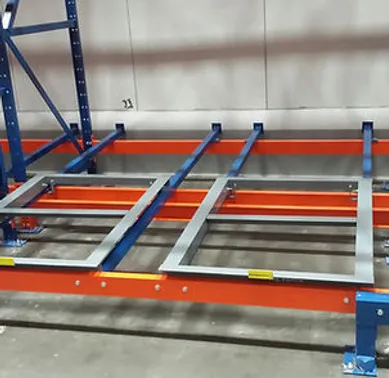Some disadvantages of high density pallet storage systems are; less access to all stock at any given moment (although if the stored product is all the same, it should not matter), and the expense of such systems. Selective pallet rack systems are considerably less expensive per pallet position than their higher density counterparts. In most medium to large facilities, however, high density pallet rack systems are essential, since they provide the efficiency of time and high cost facility space is better optimized.
Bay Area, California Office 510-409-1989 | Phoenix, Arizona Office (480) 773-1118
High Density Storage
High Density Storage
High Density Storage is a way to optimize the cube utilization of your warehouse From small items to large pallets, there are several solutions to consider. Here are some of the more common high density storage systems
High-Density Drawers can combine with shelving to achieve a greater storage density. These systems can even be integrated into a mobile aisle system to increase efficency of the storage footprint.


Drive-in Rack
Drive-in and drive-through (sometimes spelled Drive-thru) are storage rack configurations that allow the forklift to drive directly into the lane of stacked rows (called a bay). The difference between a drive-in and a drive-thru pallet rack system is simply whether the bays have an entry at only one end, or at both ends. Drive-in rack systems use a common entry and exit, while drive-thru systems have entry points at either end of the bay. Because a drive-in racking system has only one entrance, it uses what is called a LIFO (last in, first out) storage method. With only one entrance, the last pallet put into a row is necessarily the first one to be taken out. A drive-thru storage system, with two different entry points, can also use a FIFO (first in, first out) storage method. With a FIFO system, pallets are loaded in one end and are pushed back to the other end, where they are then at the front of the row on the opposite side. The first pallet put into such a row is the first one taken out at the other end. This system is advantageous for material with an expiration date or wherever shelf life is a major concern.
Pushback Rack (Last In First Out)
Push-back pallet rack systems are designed around the principle of organizing space by depth rather than width. This depth arrangement greatly reduces aisle space and increases storage density. In this configuration, each bay can be up to six pallets deep; each pallet stored on wheeled carts that fit onto rails. The rails are slightly angled toward the load/unload side of the rack in order to take advantage of gravity, saving enormous amounts of energy for moving heavy pallets. When a forklift sets the pallet onto the cart, it drives forward and causes the pallet to bump the next pallet, causing the entire row of pallets to roll backwards. When removing a pallet from the front position the remaining pallets immediately stage themselves forward so that the next available pallet can be accessed. Push back rack is a LIFO (last in, first out) storage system.


Pallet Flow Racking (First In First Out)
Pallet flow systems are high density pallet storage systems that utilize depth to increase capacity. This system uses a slightly inclined rail with rollers that allow pallets to move easily along the sloped plane. These systems are also called gravity flow or dynamic flow systems. The pallet flow system often has complex motion and braking systems to control the speed of the moving pallet. Pallet flow racking systems are either a FIFO (first in, first out) or a LIFO (last in, first out) storage system. If the system is loaded from the back and unloaded from the front, its FIFO; if the system is loaded and unloaded from the front its a LIFO system.
Double Deep Pallet Racking
A double deep rack system allows for storing pallets two deep. This system is used in conjuction with a double deep reach truck. Double deep is a higher dentisty storage that has a much lower intial cost of ownership compared to alternative high density pallet storage systems. There is a 50% increase in storage capacity compared to selective rack. Some of the limitations of a double deep system are the fact that there is poor visibility of the rear pallet the at higher beam elevations. Double deep is LIFO – Last in First out configuration.


Mobile Aisle Racking
Motorized mobile pallet racking is designed to maximize the use of warehouse storage space. Mobilized compact pallet racks can reduce your pallet storage area in half, or double the capacity of your pallet rack storage in the same floorspace area. Mobilized pallet racks save space by converting static access aisles into productive storage space. The mobilized compact rack storage system mounts rows of pallet racks onto heavy-duty rolling carriages and places them on floor tracks. Rows of pallet racks (up to 96’ long) move sideways along the floor tracks creating a movable floating access aisle. Typical warehouse storage facilities may have dozens of static access aisles but only one or two forklifts capable of accessing stored materials. Mobilizing pallet racks reduce the number of access aisles to match the velocity requirements of your storage area. Rows of pallet racks are moved by pushing a button or by remote control, which opens access aisles when and where they are needed.
Mobilized pallet racks have helped many organizations reduce or eliminate new building construction costs, auxiliary warehouses, building expansions, and decrease ongoing operational costs (lighting, energy, insurance) by maximizing the use of their storage floor space.